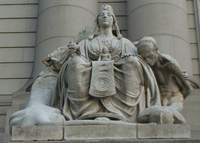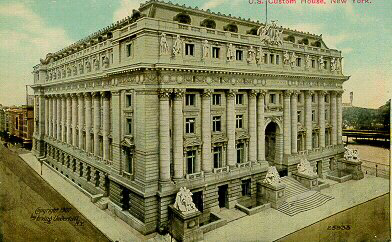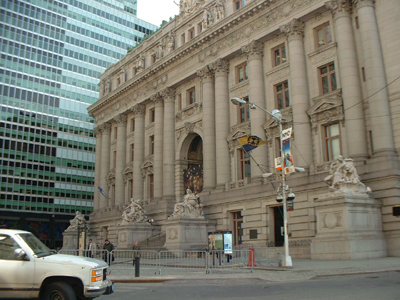 |
 |
 Asia |
 America |
 Europe |
 Africa |
For much of its history, New York City has been the most significant port city in the United States of America. Before a federal income tax was imposed in 1916, a primary source of revenue for the federal government was custom duty. With New York City the country's most active port, New York has had a Custom House since the country's founding in in 1781.
In 1899, the United States Department of the Treasury sponsored a competition to build a new U.S. Custom House on a site in Manhattan known as "Bowling Green." This was the site where, in 1626, a group of Dutch settlers "bought" Mahnattan Island from Indians for about $24.00 worth of beads. The competition was won by Cass Gilbert (1859-1934) who hailed from St. Paul, Minnesota. His magnificent Beaux Arts building not only contained the rooms necessary for collection of Custom tariffs, but was designed to show the greatness and grandeur of the United States.

The seven story structure contains 450,000 square feet of space and sits on three city blocks. It was richly decorated inside and out, including dozens of sculptures and carved images which grace the exterior of the building. Construction of the Custom House was begun in 1900 and it was completed in 1907. The building was subsequently abandoned in the 1970's and was scheduled for demolition before being saved and restored in the early 1980's. In 1987, the United States Bankruptcy Court for the Southern District of New York occupied the building and in 1994, the Smithsonian Institution's National Museum of the American Indian took over two floors of the Old Custom House.
Today, the Custom House is surrounded by a crowded grouping of office buildings in lower Manhattan, not far from the site on which the twin towers of the World Trade Center once stood.

Central to Gilbert's design of the Custom House were four separate sculptures to be placed at the front entrance of the Custom House, representing four continents (from left to right) - Asia, America, Europe and Africa. Gilbert asked both Daniel Chester French and August Saint-Gaudens both to submit designs for the scupltures. Saint-Gaudens declined the invitation, citing other work he was occupied with, so French received the commission.
French began designing the sculptures of "Continents" in 1903 and they were completed and installed in 1907 .
Art scholars consider French's "Continents" to be perhaps the best examples of architecture sculpture in the United States. Each of the four "Continents" are rich in imagery and detail. Each represent a view of the continents through French's early 20th century lens: Asia and Africa are still cloaked in mystery, Europe is in the waning years of its colonial conquests, and America (representing primarily the United States) is emerging as a new, vibrant society. Click on the images below for photos of each of the "Continents" as well as commentary on the images which make up each group.

| Daniel
Chester French: Continents: Asia. Gateway to images of
Daniel Chester French's sculpture, "Asia," found at the Old U. S. Custom House, New York City, New York.
|

| Daniel
Chester French: Continents: America. Gateway to images of
Daniel Chester French's sculpture, "America," found at the Old U. S. Custom House, New York City, New York.
|

| Daniel
Chester French: Continents: Europe. Gateway to images of
Daniel Chester French's sculpture, "Europe," found at the Old U. S. Custom House, New York City, New York.
|

| Daniel
Chester French: Continents: Africa. Gateway to images of
Daniel Chester French's sculpture, "Africa," found at the Old U. S. Custom House, New York City, New York.
|
|
All rights reserved. |